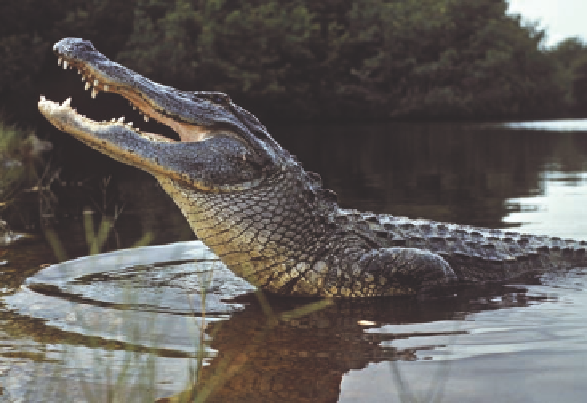Environmental Engineering Reference
In-Depth Information
6
Population
Control
Community Ecology, Population
Ecology, and Sustainability
Biodiversity
CASE STUDY
Why Should We Care about
the American Alligator?
vices, freshwater ponds and coastal wetlands found in
the alligator's habitat, shrubs and trees would fill in,
and dozens of species would disappear.
Some ecologists classify the American alligator as
a
keystone species
because of its important ecological
roles in helping maintain the structure, function, and
sustainability of the communities where it is found.
In 1967, the U.S. government placed the American
alligator on the endangered species list. Protected
from hunters, the population had made a strong
comeback in many
areas by 1975—too
strong, according to
those who find alli-
gators in their back-
yards and swimming
pools, as well as to
duck hunters, whose
retriever dogs are
sometimes eaten by
alligators.
In 1977, the U.S.
Fish and Wildlife Ser-
vice reclassified the
American alligator as
a
threatened
species in
Florida, Louisiana,
and Texas, where 90%
of the animals live. In
1987, this reclassifica-
tion was extended to
seven more states.
The recent in-
crease in demand for alligator meat and hides has cre-
ated a booming business for alligator farms, especially
in Florida. Such farms reduce the need for illegal
hunting of wild alligators.
To biologists, the comeback of the American alli-
gator is an important success story in wildlife conser-
vation. Its tale illustrates the unique role (niche) filled
by each species in a community or ecosystem and
highlights how interactions between species can affect
ecosystem structure and function. Understanding the
roles and interactions of species and the changes pop-
ulations, communities, and ecosystems undergo is the
subject of this chapter.
The American alligator (Figure 6-1), North America's
largest reptile, has no natural predators except for
humans. This species, which has survived for nearly
200 million years, has been able to adapt to numerous
changes in the earth's environmental conditions.
But matters
changed when hunters
began killing large num-
bers of these animals for
their exotic meat and
their supple belly skin,
used to make shoes,
belts, and pocketbooks.
Other people
hunted alligators for
sport or out of hatred.
Between l950 and
1960, hunters wiped
out 90% of the alligators
in Louisiana. By the
1960s, the alligator pop-
ulation in the Florida
Everglades was also
near extinction.
People who say
“So what?” are over-
looking the alligator's
important ecological
role—its
niche
—in subtropical wetland communities.
Alligators dig deep depressions, or gator holes. These
holes hold fresh water during dry spells, serve as
refuges for aquatic life, and supply fresh water and
food for many animals.
Large alligator nesting mounds provide nesting
and feeding sites for species of herons and egrets. Alli-
gators eat large numbers of gar (a predatory fish). This
helps maintain populations of game fish such as bass
and bream.
As alligators move from gator holes to nesting
mounds, they help keep areas of open water free of in-
vading vegetation. Without these free ecosystem ser-
Figure 6-1
Natural capital:
the American alligator plays important ecologi-
cal roles in its marsh and swamp habitats in the southeastern United States.
Since being classified as an endangered species in 1967, it has recovered
enough to have its status changed from endangered to threatened
species—an outstanding success story in wildlife conservation.





